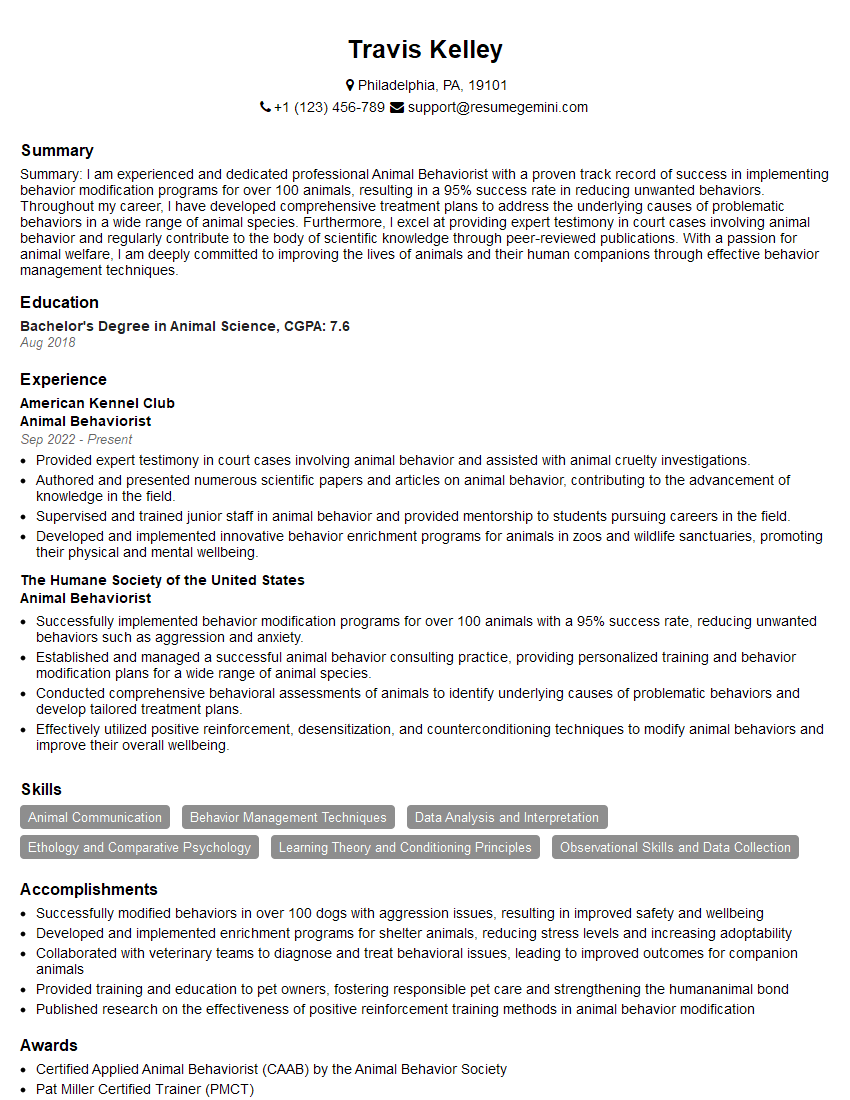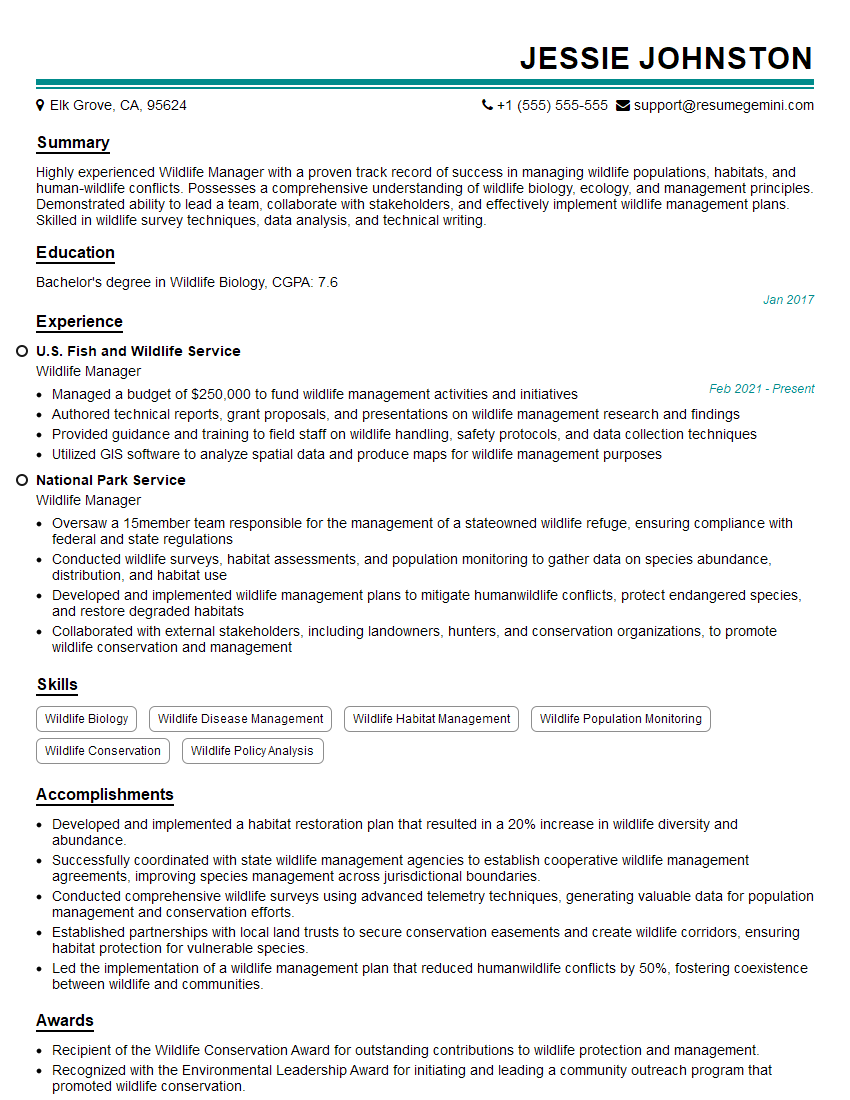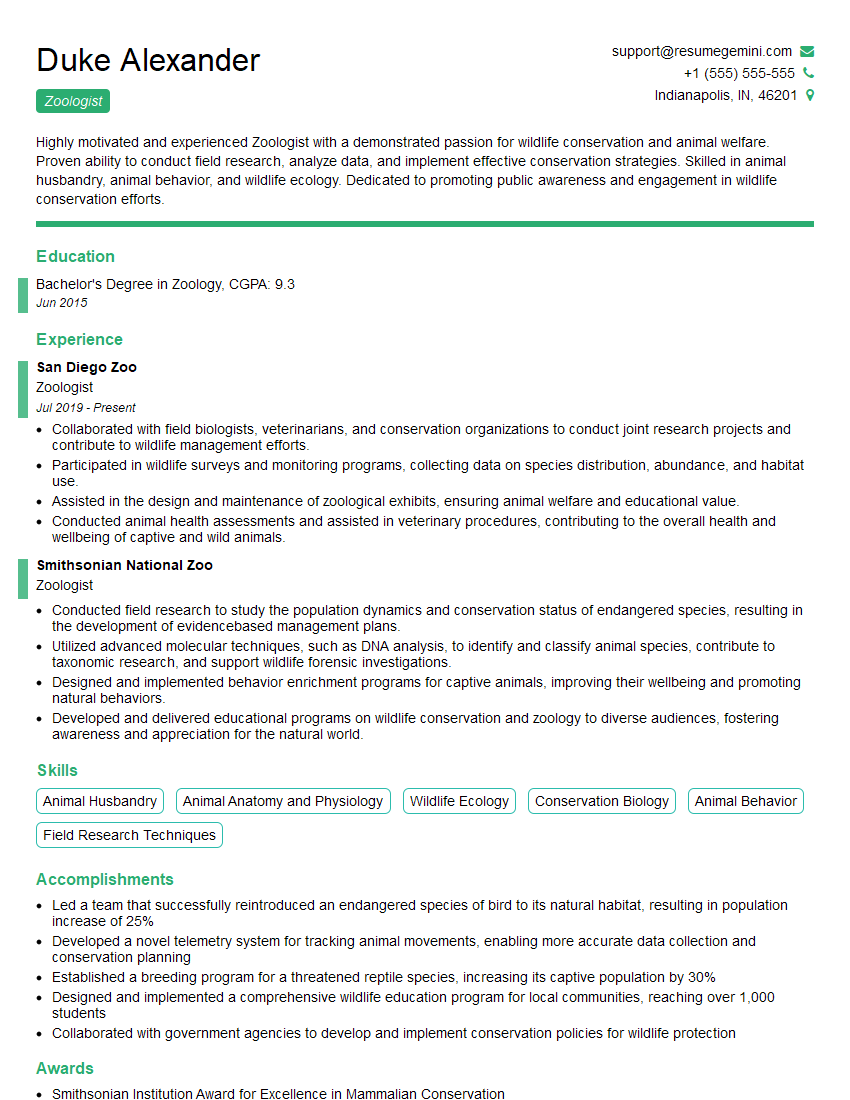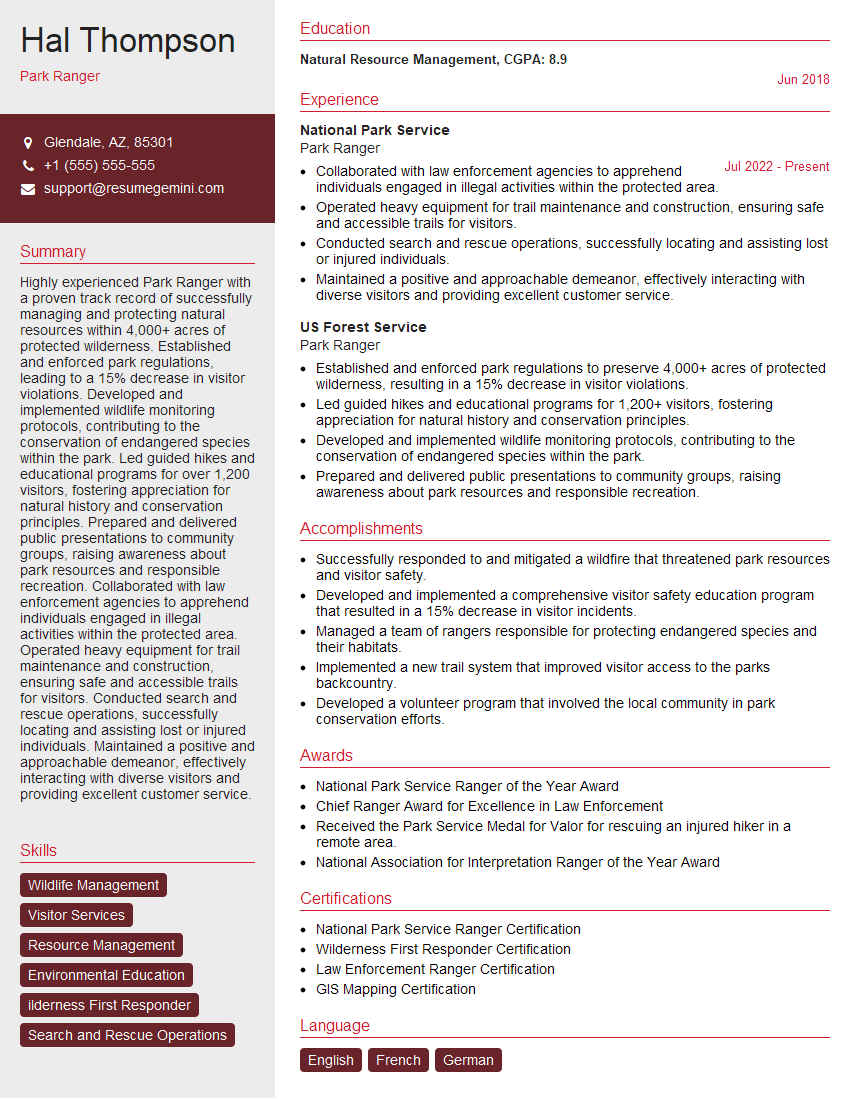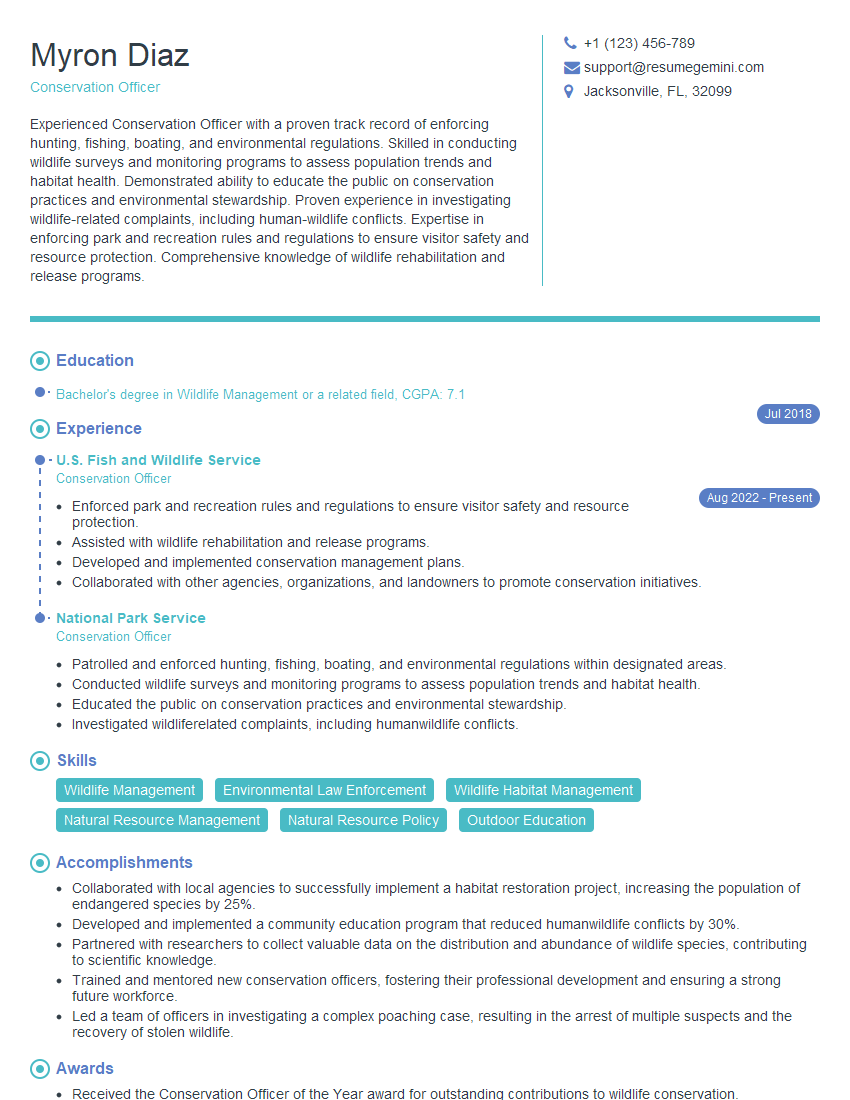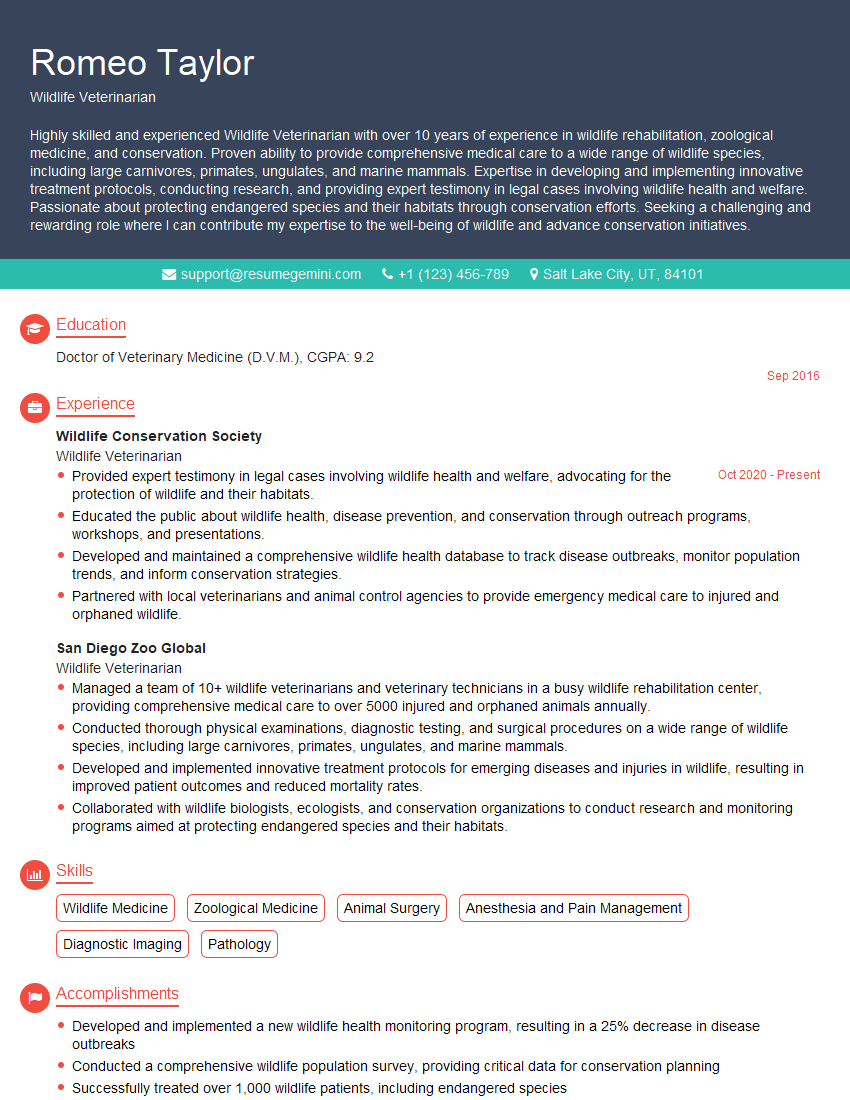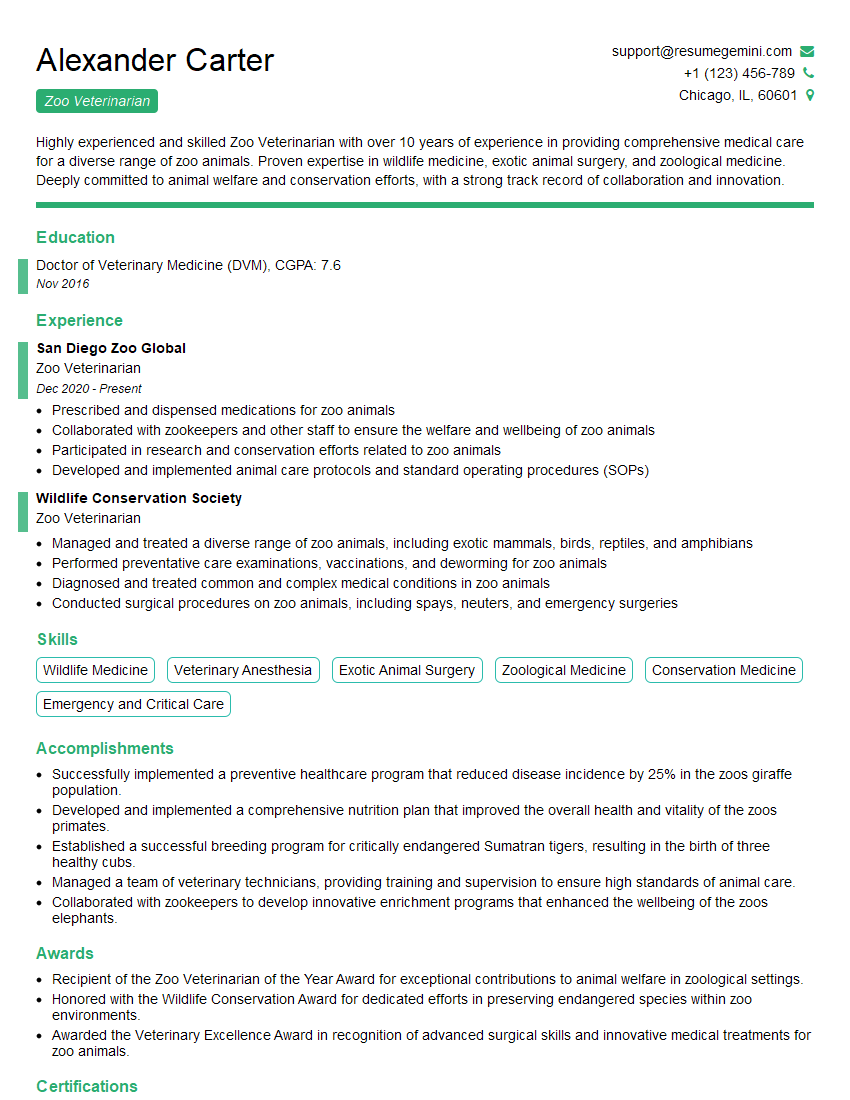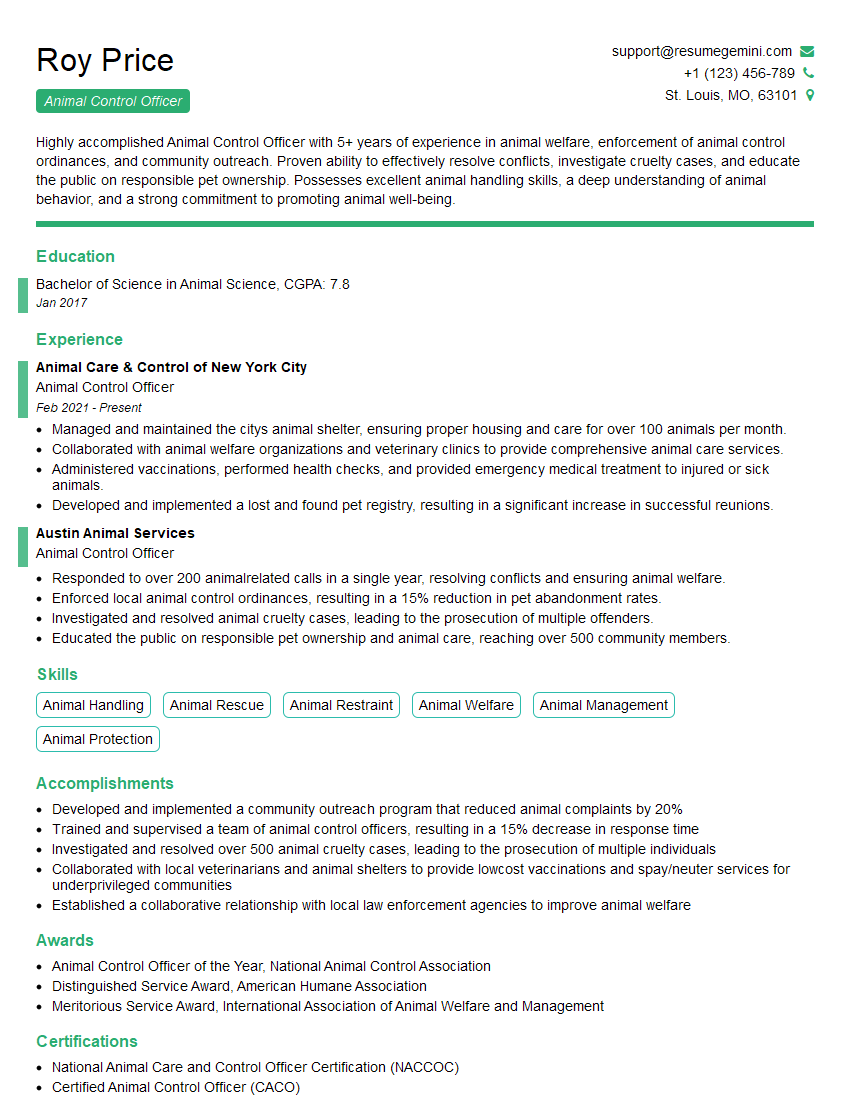The thought of an interview can be nerve-wracking, but the right preparation can make all the difference. Explore this comprehensive guide to Animal Immobilization interview questions and gain the confidence you need to showcase your abilities and secure the role.
Questions Asked in Animal Immobilization Interview
Q 1. Describe the different methods used for animal immobilization.
Animal immobilization involves techniques to safely restrain an animal, rendering it temporarily unconscious or immobile for procedures like medical examinations, treatment, relocation, or research. Methods vary depending on the species, size, temperament, and the procedure’s requirements. They broadly fall into these categories:
- Chemical Immobilization: This is the most common method, using injectable drugs (e.g., tranquilizers, anesthetics, opioids, neuroleptics) to sedate or anesthetize the animal. The choice of drug depends on the species, the desired level of immobilization, and the duration needed. For example, a combination of ketamine and xylazine is frequently used for many species.
- Physical Restraint: This involves using physical methods like nets, ropes, traps, or specialized equipment to confine the animal. This is often used in conjunction with chemical immobilization for safety and control, particularly with large or aggressive animals. For instance, a net might be used to capture a deer before darting it with an immobilizing agent.
- Combination Techniques: Often, a combination of chemical and physical methods provides the safest and most effective immobilization. This is particularly crucial for large or potentially dangerous animals, where a multi-step approach is required for controlled and safe handling. For example, a large rhino might be initially immobilized with a dart gun and subsequently restrained using ropes and other equipment to keep it immobile during procedures.
Q 2. What are the ethical considerations in choosing an immobilization technique?
Ethical considerations are paramount in animal immobilization. The primary goal is to minimize stress, pain, and suffering to the animal while ensuring the safety of both the animal and the personnel involved. Key ethical principles include:
- Minimizing Risk: Choosing the safest and most effective immobilization technique with the lowest risk of complications.
- Species-Specific Approach: Recognizing that different species have unique physiological responses to drugs and different levels of tolerance to stress.
- Proper Drug Selection and Dosage: Using drugs approved for animal use and carefully calculating doses based on the animal’s weight, species, and health condition.
- Monitoring and Post-Immobilization Care: Closely monitoring the animal’s vital signs during and after immobilization and providing appropriate post-anesthesia care.
- Justification: Ensuring that immobilization is only used when absolutely necessary and justified by a valid conservation, research, or medical purpose.
- Qualified Personnel: Employing trained and experienced personnel to administer drugs and manage the immobilization process, capable of recognizing and responding to complications.
Imagine darting a deer; you wouldn’t use the same technique, drug combination, or dosage on a small monkey. The ethical approach demands tailored attention to the specific needs of every animal.
Q 3. Explain the pharmacokinetics and pharmacodynamics of commonly used immobilization drugs.
Understanding the pharmacokinetics (drug movement in the body) and pharmacodynamics (drug effects on the body) of immobilization drugs is crucial. Commonly used drugs include:
- Ketamine: A dissociative anesthetic that produces a cataleptic state (immobility with preserved reflexes). Its pharmacokinetics involve rapid absorption, metabolism mainly in the liver, and excretion via the kidneys. Pharmacodynamically, it acts on NMDA receptors.
- Xylazine: An alpha-2 adrenergic agonist that causes sedation, analgesia (pain relief), and muscle relaxation. It’s rapidly absorbed, metabolized in the liver, and excreted in urine. Pharmacodynamically, it acts by reducing sympathetic nervous system activity.
- Tiletamine: Similar to ketamine, it’s a dissociative anesthetic.
- Buprenorphine: An opioid partial agonist offering analgesia and sedation.
The interaction of these drugs is complex, often synergistic (combined effect greater than the sum of individual effects). For example, xylazine potentiates (increases the effect of) ketamine, allowing for lower doses of each, reducing the risk of adverse effects.
Q 4. How do you assess the risk of using immobilization drugs in different species?
Assessing the risk involves considering several factors:
- Species-Specific Sensitivity: Some species are more sensitive to certain drugs than others. For example, ruminants (cows, sheep, goats) are more susceptible to xylazine-induced respiratory depression than carnivores.
- Age and Health: Young, old, or sick animals often have altered drug metabolism and increased risk of adverse reactions.
- Environmental Factors: Ambient temperature, stress levels, and hydration status can influence drug effects.
- Drug Interactions: Concurrent medication or underlying health conditions can affect drug metabolism and efficacy.
- Individual Variation: Just like in human medicine, there’s considerable individual variation in response to drugs.
A thorough pre-immobilization physical examination is crucial to identify any risk factors. Knowledge of species-specific physiology and drug responses is essential to ensure safe and effective immobilization.
Q 5. What are the potential complications associated with animal immobilization?
Potential complications associated with animal immobilization can be serious, even life-threatening. They include:
- Respiratory Depression: Reduced breathing rate and depth, often caused by opioids or alpha-2 agonists.
- Cardiovascular Problems: Bradycardia (slow heart rate), hypotension (low blood pressure), arrhythmias (irregular heartbeat).
- Muscle Rigidity: Excessive muscle stiffness, interfering with normal breathing or blood circulation.
- Seizures: Uncontrolled muscle contractions, particularly with certain anesthetic agents.
- Hypothermia: Low body temperature, due to decreased muscle activity and metabolic rate.
- Death: In severe cases, complications can lead to death.
Prophylactic measures such as pre-medication, careful monitoring of vital signs, and having appropriate resuscitation equipment are crucial to mitigate these risks.
Q 6. How do you select the appropriate dose of immobilization drugs?
Selecting the appropriate dose requires careful consideration of several factors:
- Species: Doses vary widely across species due to differences in physiology and drug metabolism.
- Weight: Doses are usually calculated based on body weight (mg/kg).
- Age and Health: Younger or older, or unwell animals, may require dose adjustments.
- Route of Administration: The chosen route of administration (e.g., intramuscular, intravenous) affects absorption and onset of action.
- Desired Level of Immobilization: The depth and duration of immobilization needed influence drug selection and dose.
Dosage guidelines are available in veterinary literature, but individual adjustments are often necessary. Experienced professionals often use a stepwise approach, starting with a lower dose and administering additional increments as needed while closely monitoring the animal’s response. Overdosing must be avoided at all costs.
Q 7. What are the signs of drug overdose and how do you respond?
Signs of drug overdose can vary depending on the drug used but might include:
- Excessive sedation or unconsciousness: Lack of response to stimuli.
- Severe respiratory depression: Slow, shallow, or absent breathing.
- Cardiovascular collapse: Weak or absent pulse, low blood pressure.
- Seizures: Uncontrolled muscle spasms.
- Cyanosis: Bluish discoloration of the mucous membranes due to lack of oxygen.
Immediate response is vital. Actions include:
- Supportive Care: Maintaining airway patency, assisted ventilation (if necessary), intravenous fluid therapy, and monitoring vital signs.
- Reversal Agents: Administering specific reversal agents to counteract the effects of certain drugs (e.g., yohimbine to reverse xylazine, atipamezole to reverse medetomidine).
- Contacting Veterinary Personnel: Seeking immediate veterinary assistance.
Rapid response and appropriate treatment can often reverse the effects of overdose and save the animal’s life.
Q 8. Describe the procedure for administering immobilization drugs.
Administering immobilization drugs requires precision and careful planning. The process begins with selecting the appropriate drug based on the species, size, and health of the animal, as well as the procedure’s duration and the desired level of immobilization. Dosage calculations are critical and often involve considering body weight and potentially other factors like age and sex. The route of administration varies depending on the situation; common methods include intramuscular (IM), intravenous (IV), or darting (using a blowgun or a projectile syringe for remote immobilization). For IM injections, proper needle placement is essential to ensure the drug reaches the muscle tissue effectively. IV administration, while offering faster onset, demands precise technique to avoid complications like vascular damage. Darting requires skill to ensure accurate placement, especially at a distance. After administering the drug, careful observation is crucial to monitor the animal’s response and adjust the dosage if necessary. Always adhere to strict safety protocols throughout the procedure, including personal protective equipment (PPE) such as gloves and eye protection. For example, when immobilizing a large moose, darting from a safe distance is essential, while a smaller animal like a deer might be safely approached for an IM injection. Different drugs have different onsets and durations of effect, and knowing these details is paramount.
Q 9. How do you monitor an animal during and after immobilization?
Monitoring an animal during and after immobilization is paramount for its safety and well-being. Continuous monitoring is crucial, involving close observation of vital signs such as respiration rate, heart rate, and body temperature. These are assessed at regular intervals, frequently in the initial stages. For example, you might check vital signs every 5 minutes immediately after drug administration, and then gradually reduce the frequency as the animal stabilizes. We often use specialized equipment like pulse oximeters and electrocardiograms (ECGs) to accurately monitor these signs, particularly during critical phases. Any abnormalities such as apnea (absence of breathing), bradycardia (slow heart rate), or significant changes in body temperature should be immediately addressed. Post-immobilization monitoring continues until the animal has fully recovered. This may involve providing supportive care, such as administering oxygen or fluids if needed. The recovery period is just as critical as the immobilization itself. Careful observation helps prevent complications and ensures the animal’s safe return to its natural state. Regular assessment for signs of pain or discomfort is also crucial.
Q 10. What are the safety procedures for handling immobilized animals?
Safety is paramount when handling immobilized animals. Immobilized animals are vulnerable and unpredictable, requiring handlers to prioritize their safety and the animal’s well-being. Always use appropriate PPE, including heavy-duty gloves, eye protection, and potentially protective clothing depending on the species and situation. Never approach an immobilized animal alone; a minimum of two experienced personnel are needed, one to monitor the animal and the other to assist with any necessary procedures. Maintain a safe distance, especially if the animal is large or prone to sudden movements. The use of safety equipment such as capture poles, soft restraints, and proper handling techniques is essential to prevent injury to both the animal and personnel. Communicate clearly with team members, coordinating all actions to avoid any sudden or alarming movements that could startle or upset the animal. The environment should be calm and quiet, minimizing stress for the animal. Remember, a seemingly docile immobilized animal might react unexpectedly. Maintaining a calm, controlled approach is key to safety.
Q 11. How do you reverse the effects of immobilization drugs?
Reversal of immobilization drugs is a critical aspect, aiming to safely return the animal to its normal state of consciousness. The choice of reversal agent depends heavily on the immobilizing drug used; specific antidotes or reversal agents exist for many immobilization drugs. For instance, atipamezole is a common reversal agent for medetomidine and dexmedetomidine. The dose of the reversal agent is carefully calculated based on the dose and type of immobilizing drug administered and the animal’s weight and condition. The reversal process should be carefully monitored, with vital signs continuously assessed. As with immobilization, close observation is crucial during the recovery phase. Unexpected reactions or complications may require further intervention. A gradual reversal is often preferred, allowing the animal to wake up slowly to minimize stress and potential problems. Post-reversal monitoring is just as vital as the reversal procedure itself. We carefully observe the animal for any signs of residual effects, delayed recovery, or complications before returning it to its habitat. For example, if an animal shows signs of weakness or disorientation after reversal, additional supportive care may be needed.
Q 12. Explain the importance of proper equipment for animal immobilization.
Proper equipment is essential for safe and effective animal immobilization. This includes specialized drug delivery systems like blowguns, dart guns, and syringes. The choice depends on factors like the species, distance, and animal behavior. For example, dart guns are preferred for large, dangerous animals at a distance, while syringes are suitable for smaller, more docile animals. Accurate dosage is crucial, so calibrated syringes and clearly labeled drugs are paramount. Monitoring equipment is equally important, ensuring that vital signs are accurately measured. This can include pulse oximeters, electrocardiograms (ECGs), and thermometers. Furthermore, appropriate safety gear is non-negotiable, encompassing protective clothing, heavy-duty gloves, eye protection, and possibly even body armor in certain cases. Capture and restraint devices, like nets, ropes, and padded slings, are crucial for handling the immobilized animal safely. Without proper equipment, the risk of injury to both the animal and personnel increases significantly, compromising the whole procedure. Regular equipment maintenance and calibration are also important to ensure accuracy and reliability.
Q 13. What are the different types of capture devices used in animal immobilization?
Various capture devices aid in animal immobilization, each suited for different species and situations. These include nets, both drop nets and hand nets, which are effective for capturing smaller animals. For larger animals, the use of tranquilizer darts, fired from blowguns or dart guns, is often necessary. The choice of dart depends on the animal’s size and the required drug delivery system. Other devices include box traps, which are suitable for trapping smaller animals, and snares, which are used with caution and usually only for animals that are easily accessible. The choice of device depends entirely on the species, environment, and safety considerations. The use of remotely operated cameras or drones to assist with the identification and location of animals in challenging terrain adds a technological dimension to capture device selection. For instance, a net would be suitable for a small deer, a dart gun might be required for an elk, and a box trap could be used for a fox. The selection requires careful assessment of factors like the animal’s size, behaviour, and the accessibility of the location.
Q 14. How do you handle emergencies during animal immobilization?
Emergencies during animal immobilization require rapid response and decisive action. These emergencies could range from respiratory or cardiac arrest to accidental injury to the animal or personnel. Rapid assessment of the situation is paramount, along with immediate actions to stabilize the animal and address the immediate threat. This often includes providing supplemental oxygen, performing cardiopulmonary resuscitation (CPR) if necessary, administering emergency medications, and contacting veterinary support for guidance. For example, if an animal experiences respiratory depression, administering a reversal agent might be necessary, while for cardiac arrest, CPR and other supportive measures are crucial. The team must work together efficiently, focusing on immediate life-saving measures. Thorough documentation of the emergency, including its cause, actions taken, and the animal’s response, is vital for future analysis and improvement of procedures. Regular training and drills simulating emergencies greatly enhance the team’s preparedness for unexpected complications.
Q 15. Describe your experience with different species and their unique immobilization considerations.
Animal immobilization techniques vary drastically depending on the species. Factors like size, temperament, physiology, and the intended procedure heavily influence the choice of immobilization method. For example, a large, aggressive rhino requires a completely different approach than a small, docile squirrel.
- Large Mammals (e.g., Rhinos, Elephants): These often require darting with powerful tranquilizers from a safe distance, considering their potential for violent reaction. The drug choice and dosage must account for their metabolism and size. Careful monitoring of vital signs during recovery is crucial.
- Birds of Prey: These are usually handled using a combination of physical restraint (gloves, hooded falconry equipment) and chemical immobilization with a carefully selected, low-dose anesthetic. The emphasis is on minimizing stress and preventing injury to the bird’s wings and talons.
- Small Mammals (e.g., Squirrels, Mice): These can often be safely restrained manually with proper techniques, potentially using a gentle anesthetic before handling. However, care must be taken to avoid injury to their delicate bones and fur.
- Reptiles: Immobilization techniques here can range from physical restraint, assisted by using hypothermia or utilizing specific anesthetic protocols tailored to the species’ metabolism, taking into account potential negative reactions.
My experience encompasses a wide range of species, and the key is always adapting my approach to minimize risk to both the animal and the personnel involved. Each species presents unique challenges and requires a thorough understanding of their specific physiological responses to immobilization agents.
Career Expert Tips:
- Ace those interviews! Prepare effectively by reviewing the Top 50 Most Common Interview Questions on ResumeGemini.
- Navigate your job search with confidence! Explore a wide range of Career Tips on ResumeGemini. Learn about common challenges and recommendations to overcome them.
- Craft the perfect resume! Master the Art of Resume Writing with ResumeGemini’s guide. Showcase your unique qualifications and achievements effectively.
- Don’t miss out on holiday savings! Build your dream resume with ResumeGemini’s ATS optimized templates.
Q 16. How do you maintain accurate records of immobilization procedures?
Maintaining accurate records is paramount for ethical and legal reasons. These records serve as a critical audit trail, essential for tracking the efficacy of procedures, identifying potential issues, and ensuring compliance with regulations. I utilize a comprehensive electronic database system that includes:
- Animal Identification: Unique identifiers (e.g., ear tags, microchips, photographs) to prevent confusion.
- Date and Time: Precise recording of the immobilization process for better analysis and traceability.
- Drug Administration: Detailed documentation of the drugs used (name, dosage, route of administration, time administered).
- Physical Restraint Methods: A clear description of any physical restraint techniques employed.
- Vital Signs: Continuous or regular monitoring and recording of heart rate, respiratory rate, body temperature, and blood pressure during and after immobilization.
- Observations: Detailed notes on the animal’s behavior, responses to drugs, and any complications encountered.
- Recovery Notes: A record of the animal’s recovery period, including the time taken to regain consciousness, any post-immobilization complications, and eventual release or transfer.
This system allows for easy retrieval of data, facilitating analysis of long-term trends and the effectiveness of different immobilization protocols. All records are securely stored and protected according to relevant data privacy regulations.
Q 17. What are the legal and regulatory aspects of animal immobilization?
The legal and regulatory landscape governing animal immobilization is complex and varies significantly across jurisdictions. It’s crucial to be fully aware of all applicable laws and regulations at both the national and local levels. Key aspects include:
- Permits and Licenses: Many regions require specific permits or licenses to handle wildlife or to administer immobilizing drugs. These permits often stipulate specific protocols and restrictions.
- Drug Control Regulations: The use of controlled substances, like many immobilizing drugs, is strictly regulated. Adherence to these regulations is mandatory.
- Animal Welfare Legislation: Laws are in place to protect animals from unnecessary pain or suffering. Immobilization procedures must minimize stress and be conducted in a manner that prioritizes animal welfare.
- Reporting Requirements: In many cases, incidents, complications, or adverse events associated with immobilization procedures must be reported to regulatory authorities.
Staying updated on the relevant legislation is ongoing and requires continuous professional development. I regularly review and update my understanding of all applicable legal and regulatory requirements to ensure compliance.
Q 18. Discuss your experience with using telemetry in animal immobilization.
Telemetry plays a vital role in modern animal immobilization, particularly for larger animals or those in remote locations. It allows for real-time monitoring of vital signs during the immobilization process and the subsequent recovery period, even from a safe distance. This significantly enhances animal welfare and safety.
I have extensive experience utilizing telemetry equipment. The process involves:
- Pre-immobilization Setup: Attaching appropriate transmitters to the animal, ensuring secure placement without causing injury.
- Data Acquisition: Receiving and interpreting vital signs data (heart rate, respiration, body temperature) via the telemetry receiver.
- Drug Dosage Adjustment: Telemetry allows for real-time assessment of the animal’s response to drugs, enabling fine-tuning of dosages as needed, reducing risk of over- or under-dosing.
- Post-Immobilization Monitoring: Continued monitoring using telemetry enables early detection of any complications during recovery.
For example, in a recent elephant immobilization, telemetry allowed us to monitor its vital signs remotely as it recovered from anesthesia, allowing for timely intervention when a slight drop in heart rate was detected. This avoided a potentially serious complication.
Q 19. How do you ensure animal welfare during immobilization?
Animal welfare is the highest priority in any immobilization procedure. Every step is taken to minimize stress and ensure the animal’s safety. This involves:
- Minimally Invasive Techniques: Using the least invasive methods possible, such as darting for large animals, whenever feasible.
- Appropriate Drug Selection: Choosing drugs with rapid onset and short duration of action whenever possible, to minimize the time the animal is incapacitated.
- Careful Monitoring: Close monitoring of vital signs during and after immobilization to detect and respond promptly to any adverse events.
- Experienced Personnel: Employing highly skilled and experienced personnel who are trained in both animal handling and the administration of immobilizing drugs.
- Appropriate Environment: Performing the immobilization in a safe and controlled environment, minimizing environmental stressors such as noise and bright light.
- Post-Immobilization Care: Providing appropriate post-immobilization care to ensure a comfortable and safe recovery.
By adhering to strict protocols and prioritizing animal welfare, we can ensure that the immobilization process is as safe and stress-free as possible for the animal.
Q 20. Explain your understanding of different drug combinations for immobilization.
Understanding drug combinations is crucial for safe and effective immobilization. The choice of drugs and their combinations depends on various factors, including species, age, health status, and the intended procedure. It’s important to remember that the effects of combining drugs can be synergistic or antagonistic, so a thorough understanding is vital.
Common drug combinations include:
- Opioids (e.g., etorphine) and tranquilizers (e.g., xylazine): This combination is frequently used for large mammals, providing analgesia (pain relief) and sedation.
- Ketamine and diazepam: Often employed for small mammals and birds, this combination offers both anesthesia and muscle relaxation.
- Tiletamine/zolazepam (Telazol): A commonly used dissociative anesthetic, often used alone or in combination with other drugs, suitable for a wide range of species.
It is extremely important to understand the pharmacokinetic and pharmacodynamic properties of each drug and its potential interactions with other drugs. Incorrect drug combinations or dosages can lead to severe complications, including respiratory or cardiovascular depression, and even death. I always consult species-specific guidelines and my colleagues for any uncertainties.
Q 21. Describe your proficiency in physical restraint techniques.
Proficiency in physical restraint techniques is essential for safe and humane animal handling, especially when chemical immobilization is not feasible or as a supplementary measure to chemical immobilization. These techniques vary widely depending on the species and size of the animal.
My training encompasses a wide range of methods, including:
- Gentle Restraint Techniques: For smaller, docile animals, gentle restraint techniques such as wrapping in a towel or using specialized handling devices are used.
- Specialized Handling Equipment: Equipment such as nets, squeeze cages, and specialized gloves are used when necessary for larger or more aggressive animals.
- Teamwork and Coordination: Efficient physical restraint often requires teamwork, with multiple individuals working together in a coordinated manner to minimize stress on the animal.
- Species-Specific Techniques: Specific techniques have been developed for different animal types, taking into account their unique anatomy and temperament. For instance, appropriate techniques for handling a bird are significantly different from those used for a reptile.
Safety is always paramount. I prioritize my own safety and the safety of my colleagues during every restraint procedure. Thorough training and regular practice are essential to maintain proficiency in these techniques.
Q 22. How do you adapt your immobilization techniques to different environmental conditions?
Adapting immobilization techniques to different environmental conditions is crucial for safety and efficacy. Extreme temperatures, for instance, can significantly affect drug metabolism and the animal’s physiological response. In hot climates, the drug’s effects might be accelerated, requiring lower doses or shorter intervals. Conversely, cold weather slows metabolism, potentially necessitating higher doses or longer observation periods.
Terrain also plays a vital role. A steep, rocky slope necessitates careful consideration of the animal’s potential movement after immobilization. We might choose a drug with a faster onset and a shorter duration of action to minimize the risk of injury during recovery. Similarly, dense vegetation might dictate the use of dart guns with longer barrels for accurate delivery. Always accounting for wind speed and direction ensures accurate dart placement and avoids compromising the safety of both the animal and the immobilization team.
- Example: When immobilizing a mountain goat on a steep incline, we’d opt for a fast-acting agent with a relatively short duration of effect. We’d also secure a safe landing area below the animal to prevent injuries during its recovery.
- Example: Immobilizing a deer in dense brush requires careful consideration of dart trajectory and potentially the use of a tranquilizer gun with a longer barrel for greater accuracy and range.
Q 23. What are your strategies for minimizing stress during capture and immobilization?
Minimizing stress during capture and immobilization is paramount to the animal’s well-being and the success of the procedure. Our strategies begin long before the actual immobilization. We employ techniques designed to reduce the animal’s awareness of our presence. This could involve using camouflage, minimizing human scent, and employing quiet approaches. The choice of immobilization agent is critical, selecting drugs with a smooth onset and a minimal effect on the animal’s cardiovascular and respiratory systems.
During the immobilization process itself, rapid and efficient darting or net capture minimizes the animal’s struggle. Once immobilized, we handle the animal gently and efficiently, minimizing noise and unnecessary movement. Post-immobilization care includes providing shade, a quiet environment, and monitoring vital signs to ensure quick and complete recovery. Imagine it like a delicate dance – we aim to ensure a smooth transition between the wild and human care with the least possible disruption.
Q 24. How would you handle an aggressive animal during immobilization?
Handling an aggressive animal during immobilization requires a multi-pronged approach that prioritizes safety. We begin by assessing the situation and choosing an appropriate distance from the animal. Using cover and concealment might be necessary. A combination of chemical and physical restraint techniques might be required. We may initially employ less stressful methods, such as using noise deterrents or simply observing from a safe distance, to see if the animal can be calmed down. If direct immobilization is necessary, we would utilize tranquilizer darts delivered from a safe distance, potentially with the aid of protective equipment. In extreme cases, a remote-controlled dart gun or other specialized equipment may be employed.
Safety of both the animal and the team is paramount; this means having appropriate personal protective equipment (PPE), such as body armor, protective shields, and appropriate firearms training. The choice of immobilization agent will reflect the level of aggression, leaning towards those which quickly sedate the animal. Post-immobilization, close monitoring is key to detecting and managing any complications arising from stress or the aggression itself.
Q 25. Describe your experience with post-immobilization care.
Post-immobilization care is as crucial as the immobilization procedure itself. It involves carefully monitoring the animal’s vital signs, such as respiration rate, heart rate, and body temperature. This is done continuously until the animal shows signs of full recovery. We provide supportive care, including maintaining body temperature, providing fluids if necessary, and preventing injury by gently restraining the animal if needed. The duration and intensity of this care depend on the drug used, the animal’s condition, and the environmental conditions.
Careful observation is critical for detecting potential complications, such as respiratory depression or hypothermia. Treatment for these complications varies, from administering respiratory stimulants to warming the animal. We usually maintain close contact until the animal is fully alert, able to stand and maintain its body temperature, and has regained normal movement patterns. The animal is then carefully released to its natural habitat to ensure a smooth transition back into its environment.
Q 26. How do you assess the effectiveness of an immobilization procedure?
Assessing the effectiveness of an immobilization procedure involves a multi-faceted approach. We monitor the animal’s response to the drug throughout the process, paying close attention to the onset of sedation, the depth of immobilization, and the duration of effect. We also monitor vital signs and the animal’s overall physical condition throughout and after the procedure. Smooth and rapid induction of immobilization with minimal struggling indicates effective application.
The success of the procedure is further determined by the successful completion of the intended procedure (e.g., health assessment, tagging, treatment). Post-immobilization, we observe the recovery time and the animal’s return to normal behaviour. The lack of complications during and after the immobilization procedure is also a clear indicator of effectiveness. We aim to achieve rapid and predictable immobilization, safe handling, minimal stress, and a swift and complication-free recovery – a perfect balance of efficiency and animal well-being.
Q 27. What are your ongoing professional development activities related to animal immobilization?
Ongoing professional development in animal immobilization is vital for staying current with best practices and advancements in the field. This involves attending workshops, conferences, and training sessions focusing on new drugs, techniques, and safety protocols. I actively participate in professional organizations related to wildlife management and veterinary medicine, remaining up-to-date on the latest research and publications. I regularly review and update my knowledge of the relevant regulations and guidelines relating to the capture, handling, and immobilization of different species. This also includes participating in practical training exercises to hone my skills and maintain my proficiency in various immobilization techniques.
Continual learning is key to providing safe and effective immobilization services and improving my knowledge of animal welfare. We must remain adaptable to new technologies and approaches, continuously learning and refining our skills to ensure the best possible outcome for the animal and the immobilization team.
Q 28. Describe a challenging immobilization case and how you overcame the challenges.
One particularly challenging case involved the immobilization of a large male grizzly bear in a densely wooded area with limited visibility. The bear exhibited extremely aggressive behavior, making a direct approach incredibly risky. The initial attempts using dart guns proved challenging due to the dense vegetation. We had to adapt our strategy, using a combination of remote-controlled dart guns, coupled with the use of a specialized dart that contained a high-potency tranquilizer.
To ensure safety, a highly experienced team with appropriate PPE was used. Once sedated, the bear was carefully monitored for vital signs and moved to a safer location for the necessary procedures. The success in this case required careful planning, teamwork, effective communication, and a flexible adaptation to the unexpected challenges presented by the environment and the bear’s behavior. This experience reinforced the importance of thorough risk assessment, flexible planning, and the value of specialized equipment and a highly skilled team in tackling complex immobilization situations.
Key Topics to Learn for Animal Immobilization Interview
- Physiology of Immobilization: Understanding the effects of various immobilizing agents on different animal species, including pharmacokinetics and pharmacodynamics.
- Drug Selection and Dosage: Calculating appropriate dosages based on species, weight, age, and health status, considering potential drug interactions and contraindications.
- Injection Techniques: Mastering safe and effective injection methods for various routes of administration (e.g., intramuscular, intravenous, intramedullary), minimizing stress and risk of injury to the animal and handler.
- Monitoring Vital Signs: Competently monitoring heart rate, respiratory rate, and other vital parameters during and after immobilization to ensure animal welfare and recognize potential complications.
- Reversal Agents: Knowing which reversal agents are appropriate for specific immobilizing drugs and how to administer them safely and effectively.
- Emergency Procedures: Preparing for and responding to adverse events such as respiratory depression, cardiac arrest, or allergic reactions during immobilization.
- Safety Procedures: Prioritizing personal safety and adhering to strict safety protocols when handling immobilized animals and administering drugs.
- Species-Specific Considerations: Recognizing the unique physiological and anatomical differences between species and adapting immobilization techniques accordingly.
- Ethical Considerations: Understanding and adhering to ethical guidelines for animal welfare and minimizing stress and pain during the immobilization process.
- Equipment and Supplies: Familiarity with the various tools and equipment used in animal immobilization, including drug delivery systems, monitoring devices, and restraint techniques.
Next Steps
Mastering animal immobilization is crucial for advancing your career in veterinary medicine, wildlife management, or related fields. It demonstrates a commitment to animal welfare and showcases your technical skills and problem-solving abilities. To maximize your job prospects, create a compelling and ATS-friendly resume that highlights your expertise. ResumeGemini is a trusted resource to help you build a professional resume that stands out. Examples of resumes tailored to Animal Immobilization are available to guide you through the process.
Explore more articles
Users Rating of Our Blogs
Share Your Experience
We value your feedback! Please rate our content and share your thoughts (optional).
What Readers Say About Our Blog
Hello,
We found issues with your domain’s email setup that may be sending your messages to spam or blocking them completely. InboxShield Mini shows you how to fix it in minutes — no tech skills required.
Scan your domain now for details: https://inboxshield-mini.com/
— Adam @ InboxShield Mini
Reply STOP to unsubscribe
Hi, are you owner of interviewgemini.com? What if I told you I could help you find extra time in your schedule, reconnect with leads you didn’t even realize you missed, and bring in more “I want to work with you” conversations, without increasing your ad spend or hiring a full-time employee?
All with a flexible, budget-friendly service that could easily pay for itself. Sounds good?
Would it be nice to jump on a quick 10-minute call so I can show you exactly how we make this work?
Best,
Hapei
Marketing Director
Hey, I know you’re the owner of interviewgemini.com. I’ll be quick.
Fundraising for your business is tough and time-consuming. We make it easier by guaranteeing two private investor meetings each month, for six months. No demos, no pitch events – just direct introductions to active investors matched to your startup.
If youR17;re raising, this could help you build real momentum. Want me to send more info?
Hi, I represent an SEO company that specialises in getting you AI citations and higher rankings on Google. I’d like to offer you a 100% free SEO audit for your website. Would you be interested?
Hi, I represent an SEO company that specialises in getting you AI citations and higher rankings on Google. I’d like to offer you a 100% free SEO audit for your website. Would you be interested?
good

